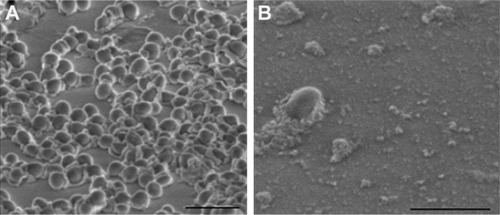Abstract
The antibacterial activity of gold nanorod (GNR) suspensions of different surface functionalities was investigated against standard strains of Staphylococcus aureus and Propionibacterium acnes, taking into consideration two commonly “overlooked” factors: the colloidal stability of GNR suspensions upon mixing with bacterial growth media and the possible contribution of “impurities/molecules” in GNR suspensions to the observed antibacterial activity. The results demonstrated that cationic polyallylamine hydrochloride (PAH)-GNR were severely aggregated when exposed to bacterial growth media compared to other GNR suspensions. In addition, the free cetyltrimethylammonium bromide (CTAB) present in GNR suspensions is most likely the origin of the observed antibacterial activity. However, the antibacterial activity of GNR themselves could not be excluded. Probing these two critical control studies prevents misinterpretations and artifacts of the antibacterial activity of nanoparticles. Unfortunately, these practices are usually ignored in the published studies and may explain the significant conflicting results. In addition, this study indicates that GNR could be a promising candidate for the treatment of skin follicular diseases such as acne vulgaris.
Introduction
Gold nanoparticles (GNP) with non-spherical shape, such as gold nanorods (GNR), are gaining particular attention as antimicrobial candidate. In addition to their biocompatibility and ease of functionalization, they extensively absorb near infra-red (NIR) light that is within an appropriate wavelength window for therapeutic applications,Citation1,Citation2 resulting in local hyperthermia that can be used to eliminate microorganisms.Citation3–Citation5 Large body of research has been conducted to explore the antibacterial activity of GNP of different shapes and physiochemical properties toward different bacterial strains, nevertheless the findings are conflicting.Citation6–Citation11
Acne vulgaris is a chronic skin inflammatory disease; it results in comedones or severe inflammatory lesions in the face, back, and chest. The pathophysiology of acne includes abnormal proliferation and differentiation of keratinocytes, increased sebum production, and hyperproliferation of microorganisms that are part of the normal skin flora, mainly Propionibacterium acnes, Staphylococcus aureus, and S. epidermidis.Citation12,Citation13 Most of the conventional available therapeutic agents for acne are usually associated with severe side effects and high cost in addition to bacterial resistance that diminish the patient compliance. GNP have several advantages in skin and follicular drug delivery;Citation14–Citation16 however, the potential antimicrobial activity of GNR against microorganisms commonly responsible for skin and follicular diseases was rarely investigated.
Despite the attractive properties of GNR, they have a high tendency to aggregate especially in the presence of high salts and biomolecules.Citation17,Citation18 The colloidal stability of GNP in biological fluids is essential in most applications, such as drug delivery, imaging, and diagnosis. Bacterial growth media (for in vitro studies) are rich in peptides, amino acids, electrolytes, and other chemicals, which may induce aggregation of nanoparticles. Despite the increasing interest in understanding the fate of nanomaterials in biological media,Citation19–Citation21 to the best of our knowledge, no systematic investigations on the colloidal stability of GNR when mixed with bacterial growth media were conducted in the literature. Ignoring such a critical factor will ultimately lead to serious misinterpretations of the results and outcomes. Similarly, the toxic effect of free molecules and impurities such as cetyltrimethylammonium bromide (CTAB) on bacterial culture was not previously evaluated in the studies which explored the antibacterial activity of GNR prepared using CTAB.
Herein, the antibacterial activity of GNR of different surface chemistry was investigated against S. aureus and P. acnes, which contribute to the pathogenesis of acne vulgaris. In addition, two critical controls were systematically investigated while measuring the antibacterial activity of GNR; first, the colloidal stability of GNR suspensions of different surface chemistry upon mixing with the bacterial growth media. Second, the antibacterial activity of the supernatants and the extra-purified GNR suspensions compared to the original GNR suspensions.
Materials and instrumentations
The following materials were obtained from Sigma Aldrich Co., St Louis, MO, USA: chloroauric acid (HAuCl4·3H2O, 99.9%), sodium borohydride (NaBH4, 99%), silver nitrate (AgNO3, 99%), ascorbic acid (99%), polyallylamine hydrochloride (PAH, MW ∼15,000 g/mole), polyacrylic acid (PAA, sodium salt, MW ∼15,000 g/mole), methoxy polyethylene glycol thiol (m-PEG-SH, MW ∼2,000 g/mole), CTAB (99%), sodium chloride (NaCl), poly-L-lysine solution, and epoxy embedding medium kit.
Cystamine dihydrochloride (97%) was obtained from Acros, UK. Glutaraldehyde (25%) was obtained from Koch-Light Laboratories Ltd., UK. Formvar-coated copper transmission electron microscope (TEM) grids (300 meshes) were obtained from Ted Pella Inc., Canada. Ninety-six-well plates and 24-well plates were obtained from Greiner bio-one, Germany.
Nutrient broth, reinforced clostridial broth, agar bacteriological (agar no 1), nutrient agar, Mueller–Hinton broth, S. aureus ATCC 29213, and P. acnes ATCC 11827 were obtained from Oxoid, UK. CO2 generator sachets (15%) were obtained from Thermo Fisher Scientific, Waltham, MA, USA.
Ultraviolet–visible (UV-vis) absorption spectra of GNR were determined using UV-vis spectrophotometer (Spectrascan 80D, Biotech Eng., UK) over the range of 400–1,100 nm. TEM images and scanning electron microscope (SEM) images were obtained using Versa 3D, FEI, Holland, operating at 30 kV. Dynamic light scattering (DLS) and zeta potential analysis were performed using Microtrac Zetatrac, Betatek Inc., Canada. Centrifugation of suspensions was performed using Centrifuge Z 216 M, Hermle Labortechnik, Germany.
All chemicals were used as received from suppliers, and all solutions used in preparation of GNP were prepared with purified 18 MΩ water. All glassware were cleaned with aqua regia thoroughly and rinsed with purified 18 MΩ water before use.
Methods
Synthesis of CTAB-capped GNR (CTAB-GNR)
CTAB-GNR were synthesized according to the seed-mediated surfactant-assisted wet-chemical method.Citation22 For the seed synthesis, a solution of 0.25 mM HAuCl4 was prepared in 0.1 M CTAB. NaBH4 (0.6 mL, 10 mM) was added to 10 mL of gold-CTAB solution with stirring. For GNR synthesis, the following agents were added to the CTAB aqueous solution (95 mL, 0.1 M) with gentle mixing: AgNO3 solution (1.1 mL, 10 mM) to get GNR with aspect ratio (AR; length/width) of ∼4, HAuCl4 solution (5 mL, 10 mM), ascorbic acid solution (0.55 mL, 0.1 M), and finally seed solution (0.12 mL). GNR mixture left undisturbed at 25°C overnight. To get rid of the excess CTAB, GNR suspension was centrifuged twice for 15 min at 12,000 rpm, and the pellets were resuspended in purified 18 MΩ water.
PAA coating of CTAB-GNR
To each 1.0 mL of twice purified CTAB-GNR suspension, 0.2 mL of PAA solution (10 mg/mL prepared in 10 mM NaCl solution) and 0.1 mL NaCl solution (10 mM) were added simultaneously.Citation23 The solution was mixed and left for 30 min. To get rid of the excess PAA polymer after coating, the coated GNR suspension was centrifuged for 10 min at 10,000 rpm, and the pellets were resuspended in purified 18 MΩ water.
PAH coating of PAA-GNR
To each 1.0 mL of purified PAA-GNR suspension, 0.2 mL of PAH solution (10 mg/mL prepared in 10 mM NaCl solution) and 0.1 mL NaCl solution (10 mM) were added simultaneously.Citation23 The solution was mixed and left for 30 min. To get rid of the excess PAH polymer, the coated GNR suspension was centrifuged for 10 min at 10,000 rpm, and the pellets were resuspended in purified 18 MΩ water.
PEGylation of GNR (PEG-GNR)
To each 1.0 mL of twice cleaned CTAB-GNR suspension, 0.1 mL of PEG-SH solution (10 mg/mL) was added and mixed for 12 h.Citation24 To get rid of the excess PEG-SH polymer after coating, the coated GNR suspension was centrifuged twice for 10 min at 10,000 rpm, and the pellets were resus-pended in purified 18 MΩ water.
Preparation of PEG-cystamine-GNR (PEG-Cys-GNR)
To each 1.0 mL of twice cleaned CTAB-GNR suspension, 0.1 mL of PEG-SH solution (5 mg/mL) were added and mixed for 6 h. To get rid of the excess PEG polymer after coating, the coated GNR suspension was centrifuged for 10 min at 10,000 rpm, and the pellets were resuspended in purified 18 MΩ water. To each 10 mL of purified PEG-GNR suspension, 1.0 mL of cystamine dihydrochloride (30 mM) was added and mixed overnight. To get rid of the excess cystamine dihydrochloride after coating, the coated GNR solution was centrifuged for 10 min at 10,000 rpm, and the pellets were resuspended in purified 18 MΩ water.Citation25
Evaluation of colloidal stability of PEG-GNR, PAA-GNR, PAH-GNR, and PEG-Cys-GNR suspensions upon mixing with bacterial growth media
A volume of 100 μL (4.0, 2.0, and 1.0 nM) of each PEG-GNR, PAA-GNR, PAH-GNR and PEG-Cys-GNR suspensions was mixed with 100 μL of bacterial growth media (Mueller–Hinton broth or reinforced clostridial broth) and incubated either aerobically at 37°C for 24 h in Mueller–Hinton broth or under anaerobic conditions at 37°C for 72 h in reinforced clostridial broth. The color change of the mixtures was observed, and the optical spectra were recorded to follow aggregation of nanoparticles. All experiments were done in triplicate.
Assessment of minimum inhibitory concentration (MIC) of GNR suspensions (PEG-GNR, PAA-GNR, and PEG-Cys-GNR) and free ligand solutions (PEG-SH, PAA, and cystamine dihydrochloride) against S. aureus and P. acnes
Overnight culture of S. aureus and 72 h culture grown under anaerobic conditions (15% CO2) of P. acnes were used in this study. MIC of each GNR suspension (PEG-GNR, PAA-GNR, and PEG-Cys-GNR) was determined against S. aureus and P. acnes using twofold broth microdilution method in 96-well plates.Citation26,Citation27 Double-strength medium (100 μL) of Mueller–Hinton broth for S. aureus or reinforced clostridial broth for P. acnes was used to fill the first experimental well. The other wells were filled with single-strength medium (100 μL). A volume of 100 μL of GNR suspensions (4.0 nM) was added to the first well. Double fold serial dilutions were then carried out across the plate. A volume of 10 μL of the cultured microorganisms (S. aureus or P. acnes) was used to inoculate each well to achieve an inoculum size of ca. 1.5×106 CFU/mL. The plates were then incubated aerobically at 37°C for 24 h for S. aureus or under anaerobic conditions at 37°C for 72 h for P. acnes. MIC was expressed as the mean concentration between the well showing growth (turbidity) and that showing no growth.Citation27 Negative controls were performed with only sterile broth, and positive controls were performed with only bacterial culture with media in the wells.
MIC of the following ligand solutions: PEG-SH (50 mg/mL), PAA (10 mg/mL), and cystamine dihydrochloride (30 mM) was determined as described earlier. The experiments were done in triplicate.
Assessment of MIC of supernatants of GNR suspensions and the extra-purified GNR suspensions (GNR 2) against S. aureus and P. acnes
A certain volume of each prepared GNR suspension (PEG-GNR, PAA-GNR, and PEG-Cys-GNR) was centrifuged at 10,000 rpm for 10 min. The MIC of 100 μL of the resultant supernatant of each GNR suspension was measured against S. aureus and P. acnes using the method described in the “Assessment of MIC of GNR suspensions (PEG-GNR, PAA-GNR, and PEG-Cys-GNR) and free ligand solutions (PEG-SH, PAA, and cystamine dihydrochloride) against S. aureus and P. acnes” section.
The resultant pellets after centrifugation of each GNR suspension were reconstituted with ultrapure water to obtain a concentration of 4.0 nM of “an extra-purified GNR” suspension, presented as GNR 2. The MIC of each GNR 2 suspension was measured as described in the “Assessment of MIC of GNR suspensions (PEG-GNR, PAA-GNR, and PEG-Cys-GNR) and free ligand solutions (PEG-SH, PAA, and cystamine dihydrochloride) against S. aureus and P. acnes” section.
A certain volume of each GNR 2 suspension was centrifuged again, and MIC of the second resultant supernatant, presented as “supernatant 2” (100 μL), was measured again against S. aureus and P. acnes. The MIC values of the supernatants are presented as the concentration of GNR at which its corresponding supernatant caused an effect. The experiments were done in triplicate.
Assessment of minimum bactericidal concentration (MBC) of GNR suspensions against S. aureus and P. acnes
The setup of MIC testing described in the “Assessment of MIC of GNR suspensions (PEG-GNR, PAA-GNR, and PEG-Cys-GNR) and free ligand solutions (PEG-SH, PAA, and cystamine dihydrochloride) against S. aureus and P. acnes” section was used for the determination of the MBC values for GNR suspensions using the standard plate count method.Citation27,Citation28 From each well showing no turbidity, as well as from the control, a volume of 100 μL was transferred to 900 μL of normal saline. Tenfold serial dilution was carried out and 100 μL of each diluted mixture (five mixtures) were spread onto nutrient agar plates for S. aureus or reinforced clostridial agar for P. acnes and incubated at 37°C for 24 h for S. aureus or under anaerobic condition for P. acnes. Neutralization of the antimicrobial activity of the tested compound was achieved by dilution. The MBC value is defined as the lowest concentration showing no growth after incubation. The experiment was done in triplicate.
SEM imaging of S. aureus treated with PEG-GNR
SEM imaging of S. aureus treated with PEG-GNR suspension was carried out using poly-L-lysin-coated slide.Citation29 A volume of 100 μL of PEG-GNR suspension (1.25 nM) was mixed with 100 μL of Mueller–Hinton broth and 10 μL of microorganism (ca. 1.5×106 CFU/mL) and incubated for 1 h. The mixture was then centrifuged at 15,000 rpm for 20 min, the supernatant was removed, and the pellets were suspended in normal saline. After that, 50 μL of the suspension was transferred onto the slide and kept until dry. The sample was then fixed in 3% glutaraldehyde for 3 h and imaged by SEM. SEM imaging of untreated S. aureus was performed as a control.
Statistical analysis
Statistical analysis was performed by applying unpaired t-test using GraphPad Prism version 6.0 (San Diego, CA, USA). Results were considered significant when p<0.05.
Results
Synthesis and characterization of GNR of different surface chemistry
Adopting available protocols, CTAB-GNR, anionic PAA-GNR, cationic PAH-GNR, and neutral PEG-GNR suspensions were successfully synthesized (). Another cationic GNR suspension with superior stability was prepared utilizing cystamine hydrochloride and PEG moieties as per reported protocol ().Citation25 The prepared GNR suspensions were characterized by UV-vis absorption spectroscopy, zeta potential, and TEM imaging. Optical spectra showed typical transverse and longitudinal plasmon peaks of CTAB-GNR (520, 800 nm, respectively) () with length, width, and aspect ratio of ∼49.5 nm, ∼12 nm, and ∼4.2, respectively, as confirmed by TEM analysis (). The effective surface charge of CTAB-GNR, PAH-GNR, and PEG-Cys-GNR was cationic (+26, +59, and +55 mV respectively), PAA-GNR were anionic (−72 mV) and PEG-GNR were around neutral (−6 mV) ().
Figure 1 Functionalization of CTAB-GNR surface with: (A) anionic polyelectrolyte, PAA; (B) cationic polyelectrolyte, PAH; (C) neutral PEG-SH; and (D) PEG-SH followed by cationic cystamine hydrochloride.
Abbreviations: CTAB, cetyltrimethylammonium bromide; GNR, gold nanorods; PAA, polyacrylic acid; PAH, polyallylamine hydrochloride; PEG-SH, polyethylene glycol thiol.
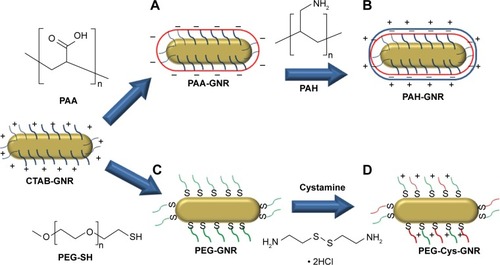
Figure 2 Characterization of GNR of different surface chemistry as labeled.
Notes: (A) UV-vis absorption spectra of GNR suspensions (real picture of GNR vials is shown in the inset). (B) Effective surface charge of GNR functionalized with different ligands. (C) TEM images of GNR of different surface chemistry. Scale bar =200 nm.
Abbreviations: CTAB, cetyltrimethylammonium bromide; GNR, gold nanorods; PAA, polyacrylic acid; PAH, polyallylamine hydrochloride; PEG, polyethylene glycol; TEM, transmission electron microscope; UV-vis, ultraviolet–visible.
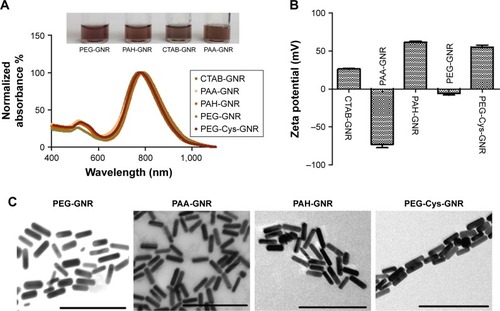
Colloidal stability of PEG-GNR, PAA-GNR, PAH-GNR, and PEG-Cys-GNR upon mixing with bacterial growth media
The stability results upon mixing of GNR suspensions of different surface chemistry with Mueller–Hinton broth are presented in . The color of GNR suspensions and bacterial growth media are deep brown and creamy yellow, respectively. The color of a stable mixture of GNR suspension and growth medium is deep brown. Neutral (PEG-GNR), anionic (PAA-GNR), and cationic (PEG-Cys-GNR) suspensions showed no color change or UV-vis absorption peak broadening, which confirmed their excellent colloidal stability upon mixing with growth medium over 24 h (). However, PAH-GNR suspension showed color change and UV-vis absorption peak broadening after 1 h of incubation with the growth medium, and a complete aggregation and precipitation out of the suspension after 24 h ().
Figure 3 UV-vis absorption spectra of (A) PEG-GNR, (B) PAA-GNR, (C) PAH-GNR, and (D) PEG-Cys-GNR suspensions before (solid lines) and after (dashed lines) mixing with nutrient growth (Mueller–Hinton broth) over 24 h.
Abbreviations: GNR, gold nanorods; PAA, polyacrylic acid; PAH, polyallylamine hydrochloride; PEG, polyethylene glycol; UV-vis, ultraviolet–visible.
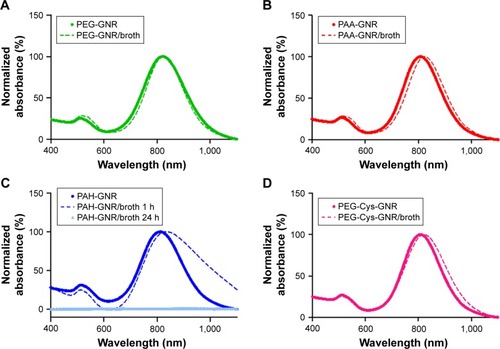
demonstrates the color of GNR suspensions of different surface chemistry when mixed with Mueller–Hinton broth medium used for S. aureus. Cationic PAH-GNR suspension exhibited color change (from brown to blue), which is a typical sign of aggregation of nanoparticles. Similar results (not shown) were obtained upon mixing of the tested GNR suspensions with reinforced clostridial broth medium.
Figure 4 Color of GNR suspensions of different surface chemistry after mixing with Mueller–Hinton broth for 24 h.
Note: The red arrow indicates the color change of PAH-GNR from brown to blue upon mixing with the media.
Abbreviations: GNR, gold nanorods; PAA, polyacrylic acid; PAH, polyallylamine hydrochloride; PEG, polyethylene glycol.
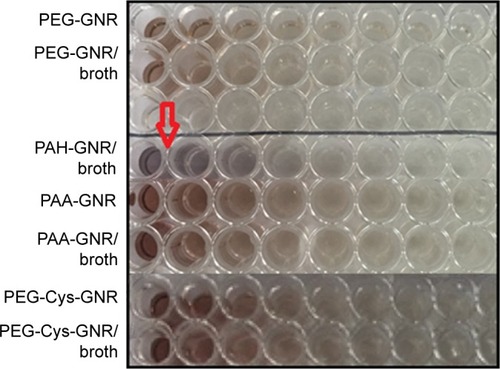
MIC and MBC of GNR suspensions, their ligands, and supernatant controls against S. aureus and P. acnes
Since PAH-GNR suspension exhibited severe aggregation upon mixing with bacterial growth media, the antibacterial activity tests were not conducted on them in this study. Instead, the cationic PEG-Cys-GNR suspension which showed excellent colloidal stability was used.
The systematic antibacterial evaluation protocol used in this study is demonstrated in .
Figure 5 Cartoon demonstration of the antibacterial activity assessment protocol of GNR suspensions and their corresponding supernatant solutions.
Notes: (A) Assessment of antibacterial activity of the original GNR suspension. (B) Assessment of antibacterial activity of the supernatant and the extra-purified GNR suspension (GNR 2). (C) Assessment of antibacterial activity of second supernatants (supernatants 2) of GNR 2 suspension.
Abbreviation: GNR, gold nanorods.
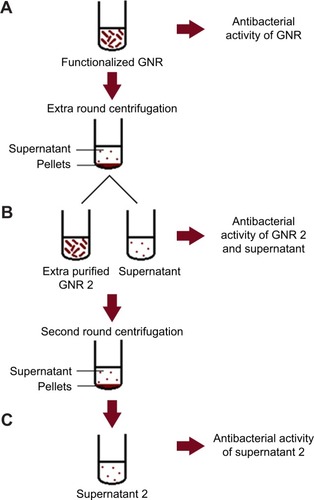
MIC values of GNR and the extra-purified (GNR 2) suspensions against S. aureus and P. acnes are presented in , where PEG-GNR and PAA-GNR suspensions exhibited statistically similar MIC values, which are significantly lower than MIC value of PEG-Cys-GNR suspension against S. aureus () and P. acnes (). On the other hand, all the ligands used for GNR functionalization (PEG-SH, PAA, and cystamine dihydrochloride) did not show any bacterial growth inhibition over the wide range of concentrations used.
Figure 6 MIC values of GNR and their supernatants against (A) Staphylococcus aureus and (B) Propionibacterium acnes. PEG-Cys-GNR supernatant showed no MIC value. (C) MIC values for GNR and GNR 2 against S. aureus and P. acnes.
Notes: MIC values are presented as mean ± SD (n=4). Unpaired t-test was used to evaluate the differences; *p<0.05. **p<0.01.
Abbreviations: GNR, gold nanorod; MIC, minimum inhibitory concentration; PAA, polyacrylic acid; PEG, polyethylene glycol.
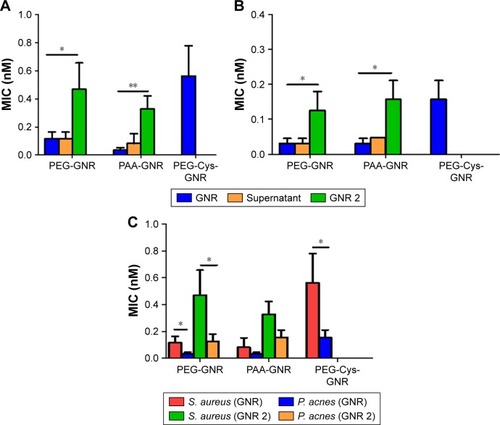
Interestingly, the supernatant of PEG-GNR suspension showed similar antibacterial activity to its original PEG-GNR suspension against S. aureus. However, the MIC value of the extra-purified PEG-GNR (PEG-GNR 2) was significantly higher than that of the PEG-GNR (0.461 vs 0.117 nM; ). The supernatant of PEG-GNR 2 suspension “ie, supernatant 2” showed no antibacterial activity. Similar results were observed for the anionic PAA-GNR against S. aureus, where the MIC of the original PAA-GNR suspension showed similar antibacterial activity to its corresponding supernatant. However, the MIC value of the extra-purified PAA-GNR (PAA-GNR 2) was significantly higher than that of the original PAA-GNR suspension (0.328 vs 0.082 nM, ). On the other hand, the supernatant of cationic PEG-Cys-GNR showed no antibacterial activity against S. aureus, and the MIC value of PEG-Cys-GNR is comparable to both MIC values of the extra-purified PEG-GNR 2 and PAA-GNR 2 against S. aureus ().
Similar trend of results was observed in the case of P. acnes (). Nevertheless, the MIC values of PEG-GNR and PEG-Cys-GNR suspensions were significantly lower against P. acnes compared to S. aureus. Similarly, the MIC value of PEG-GNR 2 was significantly lower against P. acnes compared to S. aureus ().
MBC values of GNR suspensions against S. aureus () and P. acnes () were very close to their corresponding MIC values. However, MBC value of PEG-Cys-GNR was much higher than its corresponding MIC value against both S. aureus and P. acnes.
Figure 7 MIC and MBC values of GNR suspensions of different surface chemistry against (A) Staphylococcus aureus and (B) Propionibacterium acnes.
Abbreviations: GNR, gold nanorods; MBC, minimum bactericidal concentration; MIC, minimum inhibitory concentration; PAA, polyacrylic acid; PEG, polyethylene glycol.
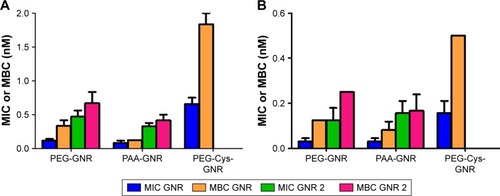
Characterization of antibacterial activity of PEG-GNR against S. aureus using SEM
presents intact untreated S. aureus cocci, while presents S. aureus treated with PEG-GNR. The second image reveals the lysis of the bacterial cells upon exposure to PEG-GNR although the GNR did not appear in this image.
Discussion
CTAB-GNR with aspect ratio (length/width) of ∼4 were prepared by wet chemical method where the cationic surfactant (CTAB) was used as a shape-directing agent. CTAB forms a bilayer on the surface of GNR to display the cationic trimethylammonium head groups to the aqueous media. Layer-by-layer (LbL) coating approach was employed to wrap CTAB-GNR with anionic polyelectrolytes resulting in anionic PAA-GNR followed by cationic polyelectrolyte resulting in cationic PAH-GNR (). PEGylated GNR were prepared by CTAB displacement on the surface of CTAB-GNR with PEG-SH (). Cationic GNR with superior stability to PAH-GNR were prepared utilizing two moieties: 1) thiolated cationic ligand (cystamine hydrochloride) to provide effective positive surface charge and 2) thiolated PEG-SH to maintain colloidal stability of GNR via steric repulsion ().Citation18,Citation30 Upon surface functionalization to prepare PAA-GNR and PAH-GNR, no significant broadening or tailing of the longitudinal peaks of the optical spectra was observed, suggesting a maintained colloidal stability without aggregation. The observed small red shift in the longitudinal plasmon peak upon surface modification with (PAA, PAH, PEG-SH) is attributed to the change in the local refractive index around the GNR core upon surface functionalization (). Furthermore, zeta potential measurement was used to determine and confirm the successful deposition of ligands onto the nanoparticle surface. For polyelectrolyte coating, effective surface charge reversal after each step of polymer deposition was achieved; the zeta potential of as-prepared GNR (CTAB-GNR) is +26 mV because of the presence of a bilayer of CTAB on the nanorod surface. It can be clearly observed that there is a charge reversal to negative (−72 mV) upon addition of anionic polyelectrolyte polymer (PAA), which confirms adsorption of the anionic polyelectrolyte (due to the ionized carboxylic acid groups) onto oppositely positive charged surfaces (CTAB-GNR) through electrostatic self-assembly. Charge reversal into +59 mV is further utilized for the subsequent adsorption of the cationic polyelectrolyte (PAH) (). On the other hand, the effective surface charge of PEGylated GNR was decreased from +26 to near neutral (−6 mV), which confirms successful displacement of CTAB with PEG-SH by self-assembly (). The slightly negative charge of PEG-GNR may be attributed to adsorption of negatively charged species (OH− or PEG-S−) on the surface of the particles. The effective surface charge of the nanorods increased from neutral to +55 mV upon addition of cystamine to PEG-GNR in order to provide positive surface charge (). TEM images of GNR functionalized with different ligands are provided in to confirm the size and shape of the nanoparticles.
GNP with non-spherical shape (GNR) were selected for the current study due to their superiority in the photothermal ablation activity, which can be utilized to eliminate bacteria and other microorganisms.
Studying the stability of nanoparticles in biological system is essential as aggregates exert different action/interaction compared to individual nanoparticles.Citation17,Citation30 Bacterial growth media are generally composed of peptones, which are mixtures of peptides and amino acids obtained by enzymatic digestion or acid hydrolysis of natural products such as animal tissues in addition to the starch and salt. These components could induce aggregation of nanoparticles. Based on the stability study results, we postulate that adsorption of peptides is the main origin of the observed cationic PAH-GNR aggregation in agreement with our previous study, where we reported that the aggregation of cationic PAH-GNR was strongly correlated with protein adsorption on the surface of GNR by forming a partial corona around them due to their low concentration.Citation25 Thus, we proposed that the low percentage of peptones in the bacterial growth media (around 2%) provides similar conditions of low protein concentration at which aggregation of nanoparticles is strongly induced. Furthermore, Alkilany et al found that PAH-GNR were stable and were not aggregated after exposure to the cell culture media that contain high percentage of proteins (around 10%), and they proved that the adsorption of proteins on the surface of GNR forming complete corona is responsible for the stabilization of the nanoparticles instead of aggregation,Citation31 which strongly supports our previous hypothesis of aggregation. On the other hand, the excellent stability of PEG-GNR and PEG-Cys-GNR suspensions upon mixing with bacterial growth media might be related to the presence of PEG shell that provides steric stabilization and prevents non-specific protein adsorption.Citation18,Citation30 In addition, the excellent stability of the anionic PAA-GNR suspension might be due to the repulsion forces between the negatively charged nanoparticles and peptones in the growth media. Unfortunately, this crucial factor of media-induced aggregation is ignored in the literature and might contribute to the observed conflicting findings.
In microbiology, MIC and MBC values are the most important tests used to evaluate the antibacterial activity of any agent. The MIC is the lowest concentration of an agent that prevents visible growth of a bacterium (at which it has bacteriostatic activity), whereas the MBC is the concentration that results in microbial death (at which it is bactericidal).Citation26,Citation28
MIC and MBC results confirmed that GNR pose bacteriostatic and bactericidal activities against S. aureus and P. acnes. Nevertheless, the role of CTAB, which is a well-known cationic surfactant used in the synthesis of GNR as a shape-directing agent and has a well-documented antibacterial activity,Citation32,Citation33 cannot be ignored. Accordingly, in addition to GNR intrinsic toxicity, other factors such as impurities and trace ions present in the GNR suspension might highly contribute to the measured activity and lead to misinterpretation of the results. In order to avoid such serious artifacts, the antibacterial activity of GNR corresponding “supernatants”, extra-cleaned GNR suspensions, and ligands used for GNR functionalization was measured in addition to the original GNR suspensions to exclude any possible antibacterial activity that may originate from free molecules in GNR suspensions (such as CTAB) rather than GNR themselves.
The results of the antibacterial activity of GNR suspensions and their supernatants suggest that free CTAB present in the supernatant solutions of GNR suspensions of different surface chemistry might contribute to the observed antibacterial activity, since the antibacterial activity of the colorless supernatant solutions was nearly identical to that of its original deep brown-colored GNR suspension (). Moreover, the extra-purified (GNR 2) suspensions have significantly higher MIC values compared to their original GNR suspensions due to decreased CTAB concentration in the suspensions after extra centrifugation. In addition, the extra-purified GNR 2 suspensions have undergone another round of centrifugation and their corresponding supernatants “supernatants 2” showed no antibacterial activity, which strongly supports the role of CTAB in the observed antibacterial activity of GNR ().
In addition to the possible contribution of CTAB molecules, the colorless supernatant solutions may also contain leftover gold ions that could contribute to the antibacterial activity. A recent study reported the antibacterial activity of Au(I) and Au(III) toward four different bacteria including S. aureus.Citation34 However, the possible contribution of these ions to the current antibacterial activity of GNR should be minimal compared to the effect of CTAB. In contrast to the GNR suspensions, the supernatant from gold nanosphere suspension (which does not contain CTAB) does not show any antibacterial activity compared to its original nanosphere suspension (data not shown), which supports the high contribution of CTAB to the current observed antibacterial activity of GNR suspensions. In agreement with our results, Alkilany et al reported the contribution of free CTAB molecules, in GNR suspension, for the toxicity of GNR on cancer culture cells. In addition, they found that gold and silver ion concentrations in the supernatants of GNR were below the detection limits of the instrument used for concentration measurement (inductively coupled plasma with atomic emission spectroscopy), and they were nontoxic.Citation31
It is worth to mention here that PEG-Cys-GNR suspension has already undergone two rounds of centrifugations during functionalization process and before antibacterial testing; one after PEGylation and another round after cystamine addition, while other functionalized GNR suspensions have undergone only one round of centrifugation after functionalization and before antibacterial testing. This explains the absence of significant difference of MIC value between PEG-Cys-GNR and the extra-purified suspensions (PEG-GNR 2 and PAA-GNR 2), and the lack of antimicrobial activity of the supernatant of PEG-Cys-GNR compared to the supernatants of PEG-GNR and PAA-GNR suspensions. It is very important to point out here that GNR pellets collected after the second extra-centrifugation round were aggregated and could not be evaluated for their antibacterial activity.
To the best of our knowledge, the antibacterial activity of GNR supernatant was not discussed previously in any of the studies that explored the antibacterial activity of GNR prepared using CTAB. However, we cannot exclude other hypotheses which support that GNR may pose intrinsic antibacterial activity, since the extra-centrifuged GNR suspensions (GNR 2) still exhibited a considerable antibacterial activity although their MIC values were significantly higher than that of original GNR suspensions. In a recent study, the MIC value of non-functionalized GNR (CTAB-GNR) using 0.2 M CTAB was ∼6.5 μg/mL against S. aureus,Citation35 which is lower than MIC values of GNR suspensions against S. aureus reported in the current study. These results support our hypothesis of CTAB contribution to the observed antibacterial activity since the concentration of CTAB in the non-functionalized GNR is much higher than that of functionalized GNR. Similarly, in another study, the MIC value of non-functionalized GNR (CTAB-GNR) was ∼15.6 μg/mL against S. aureus,Citation36 which is in the range of the currently reported MIC values of GNR suspensions against S. aureus. In the previous studies and other similar studies, neither the colloidal stability of GNR nor the supernatant control was investigated, which are two factors that might have a significant effect on the reported antibacterial activity due to the extent of interface contact and CTAB effect, respectively.
Moreover, MBC values of PEG-GNR and PEG-GNR 2, PAA-GNR and PAA-GNR 2 were very close to their corresponding MIC values, which suggests the bactericidal effect of GNR which is mainly related to the presence of CTAB and might be related also to the GNR themselves ().
Other factor that might affect the reported antibacterial activity of the GNR is their surface chemistry; nevertheless, the reported results are conflicting. In a recent study, authors reported that negatively charged GNP cannot inhibit Pseudomonas aeruginosa compared to the positively charged GNP,Citation37 while the bacterial activity of positively charged GNP was higher than the negatively charged counterparts in another study.Citation38 Our results indicated that the MIC value of the anionic PAA-GNR is not significantly different than that for neutral PEG-GNR, and the MIC value of PAA-GNR 2 is not significantly different than that for cationic PEG-Cys-GNR or neutral PEG-GNR 2 against S. aureus and P. acnes. In another study, cationic and hydrophobic nanoparticles have demonstrated growth suppression of both Gram-positive and Gram-negative bacteria.Citation9 However, some reports in the literature indicate that the degree of surface negativity and hydrophobicity of Gram-positive bacteria is not the same for all species and strains. For example, Rawlinson et al, found that cationic antimicrobial polymer is more active against S. epidermidis than S. aureus due to decreased hydrophobicity and increased negative surface charge on S. epidermidis compared to S. aureus. In addition, they demonstrated that S. aureus might develop resistance toward cationic antimicrobial agents due to modification in the peptidoglycan.Citation39
Furthermore, capping GNR with PEG reduces the tendency of particles to aggregate and increases their compatibility with biological media because it decreases the non-specific protein adsorption.Citation40 Based on these properties of PEG-GNR, and in addition to their unique hydrophobicity/hydrophilicity characteristics, we propose that PEGylation of GNR may enhance the penetration of PEG-GNR into the biological matrices with considerable stability and subsequently improve their uptake by bacteria. Nevertheless, the conflicting results in the published studies might be due to inconsistency in purification and thus the possible contribution of CTAB as an overlooked artifact.
The results of SEM imaging are in good agreement with the reported bactericidal activity of the tested GNR suspensions. Reported MBC values indicated the effectiveness of GNR in eradicating the S. aureus, which is most likely related to the presence of CTAB in GNR solutions.
Overall, the abovementioned results strongly suggest that the documented antibacterial activity of GNR in the literature might be an artifact due to the possible contribution of CTAB to the observed antibacterial activity. Accordingly, the proper design of controls in the experiments is crucial to avoid misinterpretation of results and findings. Nevertheless, we cannot exclude the intrinsic toxicity of GNR and the effect of their surface chemistry.
Furthermore, this study demonstrated that the standard growth media commonly used in the assessment of antimicrobial activities is not always suitable to be used since it might destabilize certain types of GNP, which needs further studies to design specific modified media for such nanoparticles.
Conclusion
GNR are promising candidates for eradication of S. aureus and P. acnes that are responsible for skin and follicular diseases such as acne vulgaris. However, the colloidal stability of GNR suspensions upon mixing with growth media should be evaluated first since the aggregated particles will behave differently when exposed to cells or bacteria. In addition, the contribution of CTAB to the observed antibacterial activity highlighted the importance of the proper design of controls to prevent misinterpretation of the outcomes. Nevertheless, the antibacterial activity of GNRs by themselves could not be excluded and it needs further studies to elaborate the possible mechanisms responsible for their activity.
Acknowledgments
The authors thank the Deanship of Academic research and Quality Assurance, the University of Jordan (grant number: 152/2014-2015) for financial support. Current address for NNM: Department of Pharmacy, Faculty of Pharmacy, Al-Zaytoonah University of Jordan, Amman 11733, Jordan.
Disclosure
The authors report no conflicts of interest in this work.
References
- JainPKHuangXEl-SayedIHEl-SayedMANoble metals on the nanoscale: optical and photothermal properties and some applications in imaging, sensing, biology, and medicineAcc Chem Res200841121578158618447366
- AllahverdiyevAMKonKVAbamorESBagirovaMRafailovichMCoping with antibiotic resistance: combining nanoparticles with antibiotics and other antimicrobial agentsExpert Rev Anti Infect Ther20119111035105222029522
- DykmanLKhlebtsovNGold nanoparticles in biomedical applications: recent advances and perspectivesChem Soc Rev20124162256228222130549
- NormanRSStoneJWGoleAMurphyCJSabo-AttwoodTLTargeted photothermal lysis of the pathogenic bacteria, Pseudomonas aeruginosa, with gold nanorodsNano Lett20088130230618062714
- ZharovVPMercerKEGalitovskayaENSmeltzerMSPhotothermal nanotherapeutics and nanodiagnostics for selective killing of bacteria targeted with gold nanoparticlesBiophys J200690261962716239330
- AminRMMohamedMBRamadanMAVerwangerTKrammerBRapid and sensitive microplate assay for screening the effect of silver and gold nanoparticles on bacteriaNanomedicine20094663764319663592
- ChatterjeeSBandyopadhyayASarkarKEffect of iron oxide and gold nanoparticles on bacterial growth leading towards biological applicationJ Nanobiotechnology201193421859494
- KuoYLWangSGWuCYFunctional gold nanoparticle-based antibacterial agents for nosocomial and antibiotic-resistant bacteriaNanomedicine201611192497251027622499
- LiXRobinsonSMGuptaAFunctional gold nanoparticles as potent antimicrobial agents against multi-drug-resistant bacteriaACS Nano2014810106821068625232643
- PendersJStolzoffMHickeyDJAnderssonMWebsterTJShape-dependent antibacterial effects of non-cytotoxic gold nanoparticlesInt J Nanomedicine20172924572468
- ZhouYKongYKunduSCirilloJDLiangHAntibacterial activities of gold and silver nanoparticles against Escherichia coli and bacillus Calmette-GuerinJ Nanobiotechnology2012101922559747
- WebsterGFThe pathophysiology of acneCutis2005764716164150
- BurkhartCNGottwaldLAssessment of etiologic agents in acne pathogenesisSkinmed20032422222814673275
- FernandesRSmythNRMuskensOLInteractions of skin with gold nanoparticles of different surface charge, shape, and functionalitySmall201511671372125288531
- MahmoudNNAlkilanyAMDietrichDKarstUAL-BakriAGKhalilEAPreferential accumulation of gold nanorods into human skin hair follicles: effect of nanoparticle surface chemistryJ Colloid Interface Sci20175039510228502717
- LeeOJeongSHShinWULeeGOhCSonSWInfluence of surface charge of goldnanorods on skin penetrationSkin Res Technol2013191e390e39623293910
- RauschKReuterAFischerKSchmidtMEvaluation of nanoparticle aggregation in human blood serumBiomacromolecules201011112836283920961117
- UrbanDARodriguez-LorenzoLBalogSKinnearCRothen-RutishauserBPetri-FinkAPlasmonic nanoparticles and their characterization in physiological fluidsColloids Surf B Biointerfaces2016137394926095471
- BeddowJStolpeBColePEffects of engineered silver nanoparticles on the growth and activity of ecologically important microbesEnviron Microbiol Rep20146544845825646535
- RömerIWhiteTABaaloushaMChipmanKViantMRLeadJRAggregation and dispersion of silver nanoparticles in exposure media for aquatic toxicity testsJ Chromatogr A20111218274226423321529813
- PelletierDASureshAKHoltonGAEffects of engineered cerium oxide nanoparticles on bacterial growth and viabilityAppl Environ Microbiol201076247981798920952651
- SauTKMurphyCJSeeded high yield synthesis of short Au nanorods in aqueous solutionLangmuir200420156414642015248731
- GoleAMurphyCJPolyelectrolyte-coated gold nanorods: synthesis, characterization and immobilizationChem Mater20051713251330
- AlkilanyAMAbulateefehSRMillsKKColloidal stability of citrate and mercaptoacetic acid capped gold nanoparticles upon lyophilization: effect of capping ligand attachment and type of cryoprotectantsLangmuir20143046137991380825356538
- MahmoudNNAl-QaoudKMAl-BakriAGAlkilanyAMKhalilEAColloidal stability of gold nanorod solution upon exposure to excised human skin: effect of surface chemistry and protein adsorptionInt J Biochem Cell Biol20167522323126923289
- The Clinical and Laboratory Standards Institute for antimicrobial susceptibility testing (CLSI)Wayne2016
- Al-BakriAGOthmanGBustanjiYThe assessment of the antibacterial and antifungal activities of aspirin, EDTA and aspirin-EDTA combination and their effectiveness as antibiofilm agentsJ Appl Microbiol2009107128028619302313
- M26-AMethods for Determining Bactericidal Activity of Antimicrobial Agents; Approved GuidelinePAUSA1999
- FischerERHansenBTNairVHoytFHDorwardDWScanning electron microscopyCurr Protoc Microbiol2012 Chapter 2:Unit2B.2
- MooreTLRodriguez-LorenzoLHirschVNanoparticle colloidal stability in cell culture media and impact on cellular interactionsChem Soc Rev201544176287630526056687
- AlkilanyAMNagariaPKHexelCRShawTJMurphyCJWyattMDCellular uptake and cytotoxicity of gold nanorods: molecular origin of cytotoxicity and surface effectsSmall20095670170819226599
- NakataKTsuchidoTMatsumuraYAntimicrobial cationic surfactant, cetyltrimethylammonium bromide, induces superoxide stress in Escherichia coli cellsJ Appl Microbiol2011110256857921176007
- RussellADFactors influencing the efficacy of antimicrobial agentsRussellADHugoWBAyliffeGAJPrinciples and Practice of Disinfection, Preservation and Sterilization2nd edOxfordBlackwell Science Publications19929092
- Shareena DasariTPZhangYYuHAntibacterial activity and cytotoxicity of gold (I) and (III) ions and gold nanoparticlesBiochem Pharmacol (Los Angel)2015419927019770
- Castillo-MartínezJMartínez-CastañónGMartínez-GutierrezFZavala-AlonsoNVPatiño-MarínNAntibacterial and antibiofilm activities of the photothermal therapy using gold nanorods against seven different bacterial strainsJ Nanomater201520157 Article ID 783671
- SaloutiMHeidariZAhangariAZareSEnhanced delivery of gentamicin to infection foci due to Staphylococcus aureus using gold nanorodsDrug Deliv2016231495424758188
- ZhaoYTianYCuiYLiuWMaWJiangXSmall molecule-capped gold nanoparticles as potent antibacterial agents that target Gram-negative bacteriaJ Am Chem Soc201013235123491235620707350
- VaaraMAgents that increase the permeability of the outer membraneMicrobiol Rev19925633954111406489
- RawlinsonLAO’GaraJPJonesDSBraydenDJResistance of Staphylococcus aureus to the cationic antimicrobial agent poly(2-(dimethylamino ethyl)methacrylate) (pDMAEMA) is influenced by cell-surface charge and hydrophobicityJ Med Microbiol201160pt 796897621393458
- MansonJKumarDMeenanBDixonDPolyethylene glycol functionalized gold nanoparticles: the influence of capping density on stability in various mediaGold Bull20114499105

